(Editor’s note: Each issue of Good Country, our co-founder Ed Helms will share a handful of good country artists, albums, and songs direct from his own earphones in Ed’s Picks.





(Editor’s note: Each issue of Good Country, our co-founder Ed Helms will share a handful of good country artists, albums, and songs direct from his own earphones in Ed’s Picks.





This week, our premiere round-up is chock-full of amazing new music. From a Chris Stapleton co-write from bluegrass-meets-country supergroup Wood Box Heroes to a Terry Baucom tribute from bluegrasser Ashby Frank, plus songs from Americana singer-songwriter Jack McKeon, guitarist Yann Falquet, and Asheville’s Holler Choir.
Plus, don’t miss exclusive premieres from banjo magnates Alison Brown and Steve Martin, and a posthumous release from Chick Corea with his friend and collaborator Béla Fleck.
It’s all right here on BGS – and really, You Gotta Hear This!
Wood Box Heroes, “Cannonball”
Artist: Wood Box Heroes
Hometown: Nashville, Tennessee
Song: “Cannonball”
Album: 444
Release Date: March 15, 2024 (single)
In Their Words: “‘Cannonball’ is a song I wrote a while back with Chris Stapleton. I was trying to figure out a new way to talk about the ‘love and war/love as war/love is war’ theme and of course, Chris helped to bring that to life so well. I never made a demo, just the voice memo. Hearing Chris’s amazing singing on it could be a daunting thing for lots of artists to get past, but I knew Josh Martin could handle it, so I pitched it to the Heroes for this project. It took a while to sink in with them, but I’m beyond thrilled with the treatment they gave it!” – Barry Bales
Track Credits:
Barry Bales – upright bass, vocals
Jenee Fleenor – fiddle, vocals
Josh Martin – guitar, vocals
Matt Menefee – banjo
Seth Taylor – mandolin, vocals
Produced by Wood Box Heroes.
Recorded by Brandon Bell at Sound Emporium; Nashville, Tennessee.
Mixed by Brandon Bell.
Mastered by Eric Conn at Independent Mastering; Nashville, Tennessee.
Ashby Frank, “Knee Deep in Bluegrass”
Artist: Ashby Frank
Hometown: Nashville, Tennessee
Song: “Knee Deep In Bluegrass”
Release Date: March 15, 2024
Label: Mountain Home Music Company
In Their Words: “‘Knee Deep in Bluegrass’ is a tune written and originally recorded by my friend and former Mashville Brigade bandmate, banjo legend Terry Baucom. Sadly, Terry passed away in December. When we recently gathered to start recording my next album, it happened to be the day after his funeral. All of us had Bauc and his wife, Cindy, on our minds. Remembering this song, I messaged Cindy, asking if it would be ok to record a slightly modified version of ‘Knee Deep’ as a tribute to him and she graciously approved. Bauc was performing at the first festival I ever attended in Denton, NC. His style and persona has been an inspiration to me ever since that first meeting. I think Matt Menefee, Travis Anderson, Jim Van Cleve, Seth Taylor, and Tony Creasman really nailed their parts on the tune. I hope our recording brings back fond memories for anyone who knew Terry and will honor him as he so richly deserves.” – Ashby Frank
Jack McKeon, “Last Slice of Heaven”
Artist: Jack McKeon
Hometown: Chatham, New York; currently residing in Nashville, Tennessee
Song: “Last Slice of Heaven”
Album: Talking to Strangers
Release Date: June 21, 2024
In Their Words: “I was working at a house in Williamson County, on a stretch of road that is flanked by two separate but equally cookie-cutter developments. Across from this house and squarely in the middle of all this new, was a vacant field, a decrepit barn festering in the corner. At some point that field must have meant food, crops, and a living. Now it seems to only conjure the image of an older person sitting on a potential windfall when they sell out to a developer. But with all that money comes the death of the beautiful things that made that life worth living. My boss noticed me looking at this field and facetiously said, ‘Oh, didn’t you know? These developments all come with their own complimentary field to look at.’ I wrote this song to give a voice to the person I imagined holding on to this ‘Last Slice of Heaven,’ a character at odds with the transformation around him who’s fighting to hold on to his own identity in spite of ‘a world that’s always changing what it means to be the same.'” – Jack McKeon
Track Credits:
Jack McKeon – Guitar/vocal
Ashby Frank – Mandolin/harmony vocal
Vickie Vaughn – Upright bass/harmony vocal
Christian Sedelmyer – Fiddle
Justin Moses – Banjo
Engineered by Sean Sullivan at the Tractor Shed Goodlettsville, Tennessee.
Mastered by Justin Perkins at Mystery Room Mastering.
Video Credit: Brooke Stevens
Yann Falquet, “Courage”
Artist: Yann Falquet
Hometown: Brattleboro, Vermont
Song: “Courage”
Album: Les secrets du ciel
Release Date: March 15, 2024 (single); May 3, 2024 (album)
In Their Words: “I moved from Québec to New England a couple of years ago. My instrumental background was compatible with the fiddle styles I encountered here (Appalachian, Irish, Scottish, etc.), but I quickly realized that I had to rethink the way I approached songs. Back in French Canada, traditional singers often perform unaccompanied, and rely heavily on others in the room to participate in the ‘response’ part of call-and-response songs. For this project, I began reframing these songs into a more English or American ‘folk singer’ format, and had a lot of fun coming up with interesting guitar parts in DADGAD tuning. I then collaborated with producer Quinn Bachand and a bunch of fantastic musicians to add extra musical layers to the song.
“‘Courage’ comes from the repertoire of the Voyageur folks who paddled across North America, using songs to keep paddling in rhythm. It tells the story of a young soldier who abandons war for the pursuit of love, knowing well the consequences if he gets caught.” – Yann Falquet
Track Credits:
Yann Falquet – Guitar, voice
Julia Friend – Voice
Keith Murphy – Pump organ
Trent Freeman – Violin
Quinn Bachand – Violin, bass pedal
Quinn Bachand – Producer, engineer
Charles-Émile Beaudin – Mixing engineer
Philip Shaw Bova – Masterin engineer
Holler Choir, “Hamlet Blues”
Artist: Holler Choir
Hometown: Asheville, North Carolina
Song: “Hamlet Blues”
Album: Songs Before They Write Themselves
Release Date: January 12, 2024
In Their Words: “I can’t speak to everyone else’s tastes, but for the purpose of songs that I perform and have written, ‘Hamlet Blues’ is my most timeless song. I know this because 10 years after having written it, it’s just now seeing a definitive release, and it feels no less personally relevant than the day I wrote it.
“There’s a very intentional juxtaposition between the carefree energy of the music and the existential crisis portrayed in the lyrics. It’s a cognitive dissonance that I’ve experienced in different settings many times in life, and I chose to channel that energy into this song. There’s a smiling nihilism that can be found at any college bar. Kids drinking to excess, with little regard for what’s happening tomorrow. Seemingly happy people, sitting on a fault line that is long overdue. I wanted to capture the dread that was the humming drone in my head beneath whatever pop song was blaring over the bar speakers at the time. I don’t find this sentiment any less relevant for bars I go into as an adult.” – Clint Roberts
Alison Brown & Steve Martin, “Bluegrass Radio”
Artist: Alison Brown & Steve Martin
Hometown: La Jolla, California (Alison); Waco, Texas (Steve)
Song: “Bluegrass Radio”
Release Date: March 15, 2024
Label: Compass Records
In Their Words: “This little tune brings a ton of joy to me. Alison’s playing is flawless, and my singing is flaw-full.” – Steve Martin
Chick Corea & Béla Fleck, “Remembrance”
Artist: Chick Corea & Béla Fleck
Hometown: Nashville, Tennessee
Song: “Remembrance”
Album: Remembrance
Release Date: May 10, 2024
Label: Béla Fleck Productions (Thirty Tigers)
In Their Words: “’Remembrance’ is one of the last pieces of music Chick ever recorded. It’s just one of those perfect Chick Corea tunes. It sounds to me like a New Orleans funeral march, even though it has a Latin component, like everything he did tended to.” – Béla Fleck
Photo Credits: Wood Box Heroes by Eric Ahlgrim; Ashby Frank by Melissa DuPuy
Artist: Chick Corea & Béla Fleck
Hometown: Nashville, Tennessee
Song: “Remembrance”
Album: Remembrance
Release Date: May 10, 2024
Label: Béla Fleck Productions (Thirty Tigers)
In Their Words: “’Remembrance’ is just one of those perfect Chick Corea tunes. It sounds to me like a New Orleans funeral march, even though it has a Latin component, like everything he did tended to.” – Béla Fleck
Photos by C. Taylor Cruthers and Taylor Cottrell
Artist: Alison Brown & Steve Martin
Hometown: La Jolla, California (Alison); Waco, Texas (Steve)
Song: “Bluegrass Radio”
Release Date: March 15, 2024
Label: Compass Records
In Their Words: “This little tune brings a ton of joy to me. Alison’s playing is flawless, and my singing is flaw-full.” – Steve Martin
“I’m so grateful to all the DJs for playing ‘Foggy Morning Breaking’ and for inspiring Steve to write the lyrics to ‘Bluegrass Radio.’ Thanks to Sam, Stuart, Trey, and Todd for the great playing – and to Steve for the outstanding twin banjo picking.” – Alison Brown
Track Credits:
Steve Martin – vocals, banjo
Alison Brown – banjo
Sam Bush – mandolin, harmony vocals
Stuart Duncan – fiddle
Trey Hensley – guitar, harmony vocals
Todd Phillips – bass
Recorded and mixed by Matt Coles at Compass Sound Studio, Nashville, TN.
Additional recording by Matt Coles at Echo Mountain, Asheville, NC, assisted by Julian Dreyer.
Mastered by Randy LeRoy.
Produced by Alison Brown and Garry West.
Video Credit: Filmed at Compass Sound Studio by Joseph Spence
Additional footage shot by Josh Blake and Shane Peters at Echo Mountain
Edited by Joseph Spence
Photo Credit: Madison Thorn
Last month, Sister Sadie took the stage at Nashville’s Station Inn to showcase and celebrate their latest album, No Fear. And although the title itself could be an ode to the group’s unrelenting urge to hop genre fences – from bluegrass to country to pop and back again – it’s also a nod to the resiliency of the band itself.
With No Fear, Sister Sadie showcase three-part, songbird harmonies backed by a keen musical aptitude that’s equally distributed throughout the quintet. The 13-song LP combines the “high, lonesome sound” of bluegrass with a blend of country and pop sensibilities a la The Chicks, Little Big Town, or Pistol Annies.
“There’s a space for bluegrass meets Americana meets country meets pop — that’s what I’m manifesting,” says fiddler and de facto band leader, Deanie Richardson.
To note, the Station Inn appearance was a full-circle sort of thing for the ensemble. First coming together at the storied venue by pure happenstance in December 2012, Richardson, banjoist Gena Britt, and former members guitarist Dale Ann Bradley, bassist Beth Lawrence, and mandolinist Tina Adair were simply a collection of pickers and singers from different circles in Music City.
That initial gig went extremely well, so much so that more shows were booked and things started to unfold into a full-fledged band – albeit one where the members still held day jobs and were raising families. But, the music felt right and so did the performances, so why not tempt fate and see where this ride may go?
Well, what a ride it has been thus far. Appearances on the Grand Ole Opry. Three IBMA awards for Vocal Group of the Year (2019, 2020, 2021) and one for Entertainer of the Year (2020), with Richardson taking home Fiddle Player of the Year in 2020. And a Grammy nomination for Best Bluegrass Album for the 2018 release, Sister Sadie II.
But, in recent years, three of those founding members — Bradley, Lawrence, and Adair — left to pursue other projects, which, in turn, posed one lingering question to Richardson and Britt — where to from here?
“When we started 12 years ago, when we hit that first note at the Station Inn, we felt this magical chemistry in the band,” Richardson says. “Somehow, every time we reinvent this [band], I still feel that magical chemistry when we play music.”
Instead of throwing in the towel and saying it was good while it lasted, Richardson and Britt forged ahead, come hell or high water. They regrouped and reemerged into this next, unknown chapter. Soon, Jaelee Roberts and Dani Flowers came into the fold, both bringing songwriting prowess as well as providing guitar and vocal harmonies to ideally complement Britt. Then, in 2023, bassist Maddie Dalton hopped onboard.
“It’s an eclectic group of ladies and of musical tastes,” Richardson says. “Our home, our hearts and our souls are in bluegrass music. That’s what we love, that’s our passion, but there’s a lot of room for growth there.”
The new album, it’s not bluegrass. It’s not country. It’s just good music. In my opinion, it would be a shame to pigeonhole your music.
Deanie Richardson: Well, that would be our dream, Garret, for someone to not try to put some sort of label or pigeonhole it into somewhere. But, unfortunately, it happens. We went in there with great tunes and just let them arrange themselves, let them work themselves out in the studio. And this is what we got. So, I didn’t go in with bluegrass in mind. I didn’t go in with country in mind. I just went in with all my pals, people I love — great players and great songs.
Is that more by design or just how things have evolved?
DR: I think that’s how it’s evolved. That was not the original [Sister] Sadie. That’s this combination of girls right here. When you have personnel changes like we’ve have along the way, the energy changes — everything shifts.
Gena Britt: You have to reinvent yourself.
DR: You’ve got to figure out where you land when Jaelee Roberts comes in and changes everything. And then you’ve got to figure out where you land when Dani Flowers comes in. And Maddie Dalton. We’ve had three new members. That changes the energy. It changes the vibe. It changes the feel. It changes the vocals. It changes everything. This whole band has grown organically over the last 12 years. This is just where it is right now. We’re about to go in and record a new one and, shoot, it may sound like ZZ Top. I don’t know — you never know.
And I have a lot of solidarity with that, the attitude of just go in and see what happens, see what sticks and see what works.
Dani Flowers: Every single person in this band is a big fan of good writing and good songs. Just trying to serve the song and make sure it had what it needed rather than trying to put any one certain song in a box that it might not fit in.
How does that play into personal goals with the band’s expectations? There’s a lot of a crossover factor in the music. I hear just as much country as I do bluegrass in there.
GB: We’re just going for what we feel. We want to be excited about the song as we want everybody that’s listening to be excited. When we’re in the studio, these songs were brought to life in such a great way.
With the new members, what was kind of the intent coming into the group?
Jaelee Roberts: When I was asked to audition, I was kind of flabbergasted, because I looked up to Sister Sadie. These are all my heroes playing together in a band. And I had grown up around them. It was such a surreal feeling to get to audition. I get to not only learn more from them than I was already learning from them, but I get to part of that and grow with them, bring my spin on stuff.
DF: It was definitely a no-brainer for me when it came to joining the band. I’ve known Deanie since I was 16 or 17, Gena since I was 19 or 20. I’ve always admired them both. They’re incredible at what they do. It was really great for me. I was in the music industry for a while. I had a record deal. I wrote for a publishing company. And then, I had a kid and kind of stopped doing it all for a while. So, to join a band full of women that I already love was a great way to get back into playing music.
And with founding members of a band leaving, there’s this creative vacuum that can occur, where maybe there are more opportunities for other people to step up.
DR: Oh, that’s so great, because it’s true. With the personnel changes we’ve had, there’s been more opportunities for different styles, different vocalists, different everything. It’s crazy how that energy shift just redirects everything. You find a new tunnel or rabbit hole to go down or a new vision. It’s super fun to hear those potential songs and figure out whose voice is going to work. If you listen to a song, it actually tells you where it wants to go.
GB: This band is kind of a melting pot. We all bring such different things to the band. And then, when you put it all together and mix it all together, it’s this great recipe for things that are magical. It’s just heartwarming, too. We actually hangout together when we’re not playing on the road — not a lot of bands do that.
With the band shakeup and everything that’s happened to Sister Sadie in recent years — winning the IBMA for Entertainer of the Year, switching record labels to Mountain Home — what made you decide to keep it going? Was there a moment of maybe shutting it down and doing something else?
DR: One hundred percent. You’re on it. With the last personnel change, Gena and I were on the phone like, “We’re 10 years into this thing. Is it time to call it? Maybe it’s just time.” This band happened by just a group of friends getting together and playing the Station Inn. Then, “Hey, that went really well. Let’s playing the Station Inn again.” Then, Gena starts getting calls from promoters. Do a few shows. Then, Pinecastle says, “Hey, let’s do a record.” We do a record. We do another record. We get nominated for a Grammy.
But, we’ve never really gone in 100 percent. It’s just been organic. I’ve got a ton of things going on. I’ve got a seven-year-old. Gena’s got a job and two kids. It’s never like, “Let’s form a band and let’s go do this.” It was always sort of The Seldom Scene thing — we’ll play when it makes sense. And then, I was like, “What if we give this thing everything we’ve got? What if we put in one 110 percent? What if we got a team? What if we got a manager? What if we got a new record label? What if we got a booking agent? Let’s devote one year to this 110 percent and see what happens” — that’s where we are.
I’m 52 years old. I’ve been doing this and on the road since I was 15. This is the best record we’ve ever done. Going all in was the best choice that we could’ve made.
Photo Credit: Eric Ahlgrim
March is Women’s History Month, and BGS, Good Country, and Real Roots Radio have partnered to highlight a variety of our favorite women in country, bluegrass, and roots music with our Women’s History Spotlight.
Each weekday in March at 11AM Eastern (8AM Pacific) on Real Roots Radio, host Daniel Mullins will be celebrating a powerful woman in roots music during the Women’s History Spotlight segment of The Daniel Mullins Midday Music Spectacular. Then, we will have a Friday recap here on BGS featuring the artists highlighted throughout the previous week. No list is comprehensive, but we hope to feature some familiar favorites as well as some trailblazers whose music and impact might not be as familiar to you.
You can listen to Real Roots Radio online 24/7 or via their FREE app for smartphones or tablets. You can also ask your smart speaker at home to play “Real Roots Radio.” Based out of southwestern Ohio, we feature the best in country, bluegrass, and Americana music — past and present.
Each week in March, we hope you enjoy learning more about the incredible women who have made American roots music what it is today.
Patsy Cline

One of the most impactful voices in 20th century American music, Patsy Cline’s legacy still looms large over country music. An crossover star in the genre, her timeless voice has influenced generations of country stars — Loretta Lynn, k.d. lang, Mandy Barnett, and countless others. The strength and emotion with which she sang endeared her to music fans of all walks of life; she has sold over 14 million albums and had songs on the country charts two decades after her untimely passing. Her 1973 posthumous induction into the Country Music Hall of Fame made her the first solo female artist inducted into the hallowed hall.
This week marked the anniversary of the tragic 1963 plane accident that took the lives of Patsy Cline, Cowboy Copas, Hawkshaw Hawkins, and their pilot, Randy Hughes. Although she passed away at the age of 32, there is always Patsy Cline.
Lynn Morris
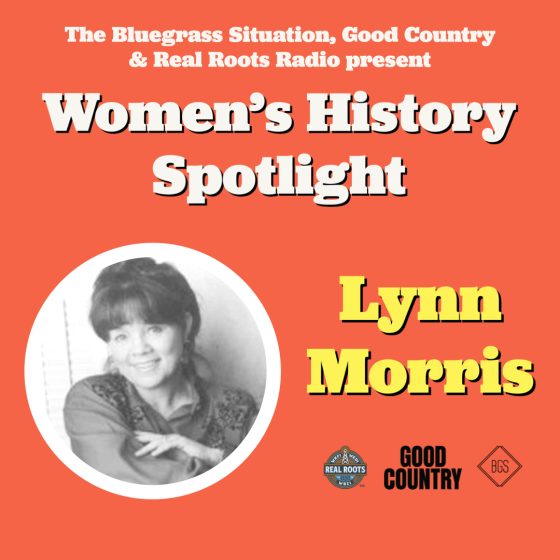
A recent inductee into the Bluegrass Music Hall of Fame, Lynn Morris is renowned in bluegrass circles for her virtuosity as a musician and her sincerity as a vocalist. The first person to win the National Banjo Championship in Winfield, Kansas twice, she is also a fantastic guitar player. After playing with Whetstone Run throughout much of the 1980s, she founded The Lynn Morris Band in 1988. Anchored by her heartfelt voice, The Lynn Morris Band featured a who’s who of future bluegrass stars over the years, including Jesse Brock, Ron Stewart, Chris Jones, Tom Adams, Jeff Autry, Audie Blaylock, and Marshall Wilborn (Lynn’s husband), among many others. She was forced to retire in 2003 due to a stroke, but her love for animals and radiant smile have continue to inspire the bluegrass community.
Connie Smith

Connie Smith was discovered at a talent contest in Columbus, Ohio at the famed Frontier Ranch by Bill Anderson, who quickly got her to Nashville where her debut single, “Once A Day,” shot to the top of the charts (her only number one hit). Connie Smith was an instant star. After many hit records, she semi-retired beginning in the late ’70s, only working sparingly while she raised her children, until she mounted a comeback in the mid ’90s. She continues to captivate Opry audiences, is still releasing powerful country albums, and was inducted into the Country Music Hall of Fame in 2012. Once billed as “Miss Cute ’n’ Country,” Eddie Stubbs more aptly (and more appropriately) dubbed her “The Rolls Royce of Country Music Singers.”
Paulette Carlson
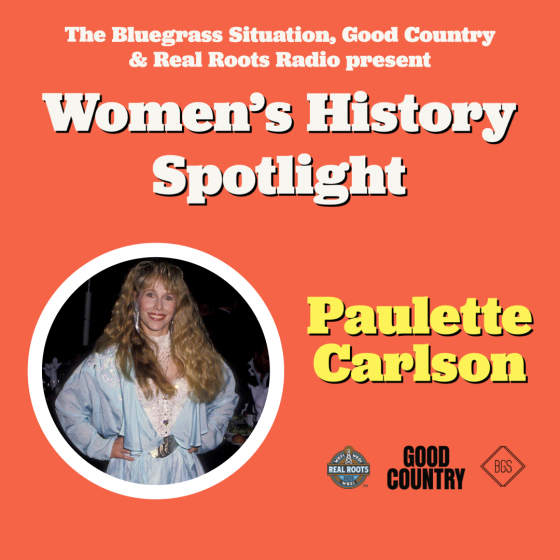
’80s and ’90s country still slaps (which is one of the few things people can agree on these days), and if you’re familiar with country music from that era, you’re definitely familiar with the voice of Paulette Carlson. A Minnesota native, her talent quickly outgrew the bars of Minneapolis and Fargo, North Dakota and she moved to Music City in the late ’70s. After working as a songwriter and releasing a few songs on her own, she formed the band Highway 101 in 1986.
On the strength of Paulette’s distinct vocals, Highway 101 quickly began churning out hit records, like “Whiskey, If You Were A Woman,” “Walkin’, Talkin’, Cryin’,” “Barely Beatin’ Broken Heart,” and their breakthrough hit, “The Bed You Made For Me” (written by Carlson). Highway 101 received “Vocal Group of the Year” honors in 1988 and 1989 at both the CMA and ACM awards. Paulette Carlson left the band in 1990 to pursue a solo career, but failed to reach the commercial success that she achieved while leading Highway 101. In recent years, she has resumed recording touring, with several songs saluting the military, inspired by her brother Gary, a Vietnam War veteran.
Lee Ann Womack
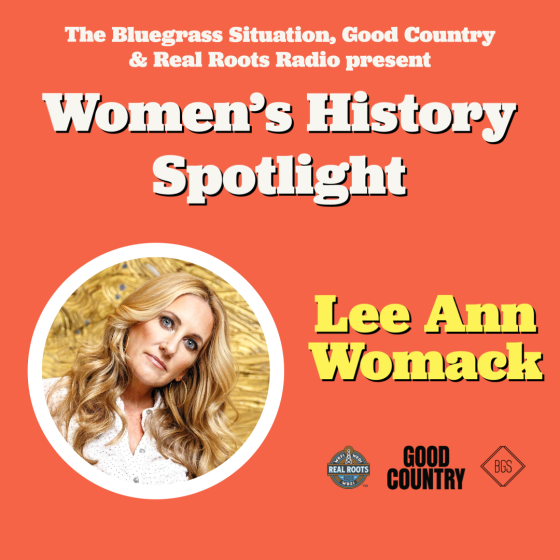
One of the most revered country vocalists of her generation, Lee Ann Womack’s impact on the current generation of female vocalists is obvious. In bluegrass alone, Sister Sadie’s Dani Flowers and Jaelee Roberts both point to her as a major influence, and before that, Flatt Lonesome’s Charli Robertson and Kelsi Harrigill did the same.
While “I Hope You Dance” is still played at nearly every graduation ceremony and high school prom, the depth of Womack’s talent and catalog is remarkable. Her ability to combine her style of traditional country with contemporary elements has allowed her to find great success outside of the genre, while unashamedly being an advocate for country music. In addition to some killer records of her own in recent years (I’m looking straight at you, The Lonely, The Lonesome & The Gone), the timelessness of her voice and the respect she has among her peers has allowed her name to pop up on some amazing all-star albums that truly run the gamut. I implore you to check out her contributions to Divided & United: Songs of the Civil War, last year’s Nashville tribute to the music of Bill & Gloria Gather, the country tribute to Elton John (Restoration), the Fisk Jubilee Singer’s 150th anniversary project, and the award-winning Industrial Strength Bluegrass album.
Patsy Montana
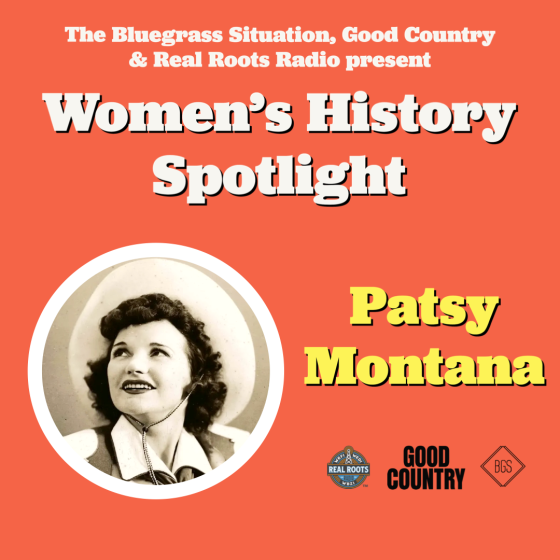
Born Rubye Rose Blevins, Patsy Montana was the original singin’ cowgirl. Her musical talent really blossomed during her time studying at what is now UCLA, where she studied violin, sang, played guitar, and yodeled on the side (which would remain a prominent part of her music). She traveled to Chicago’s World Fair with the hopes of receiving recognition for her family’s watermelon that she toted from Arkansas, but wound up auditioning for WLS’s National Barn Dance, becoming a part of the cast, and quickly becoming a radio star.
Her 1935 hit, “I Wanna Be A Cowboy’s Sweetheart,” would be country music’s first million-selling single by a female artist. She performed on WLS’s airwaves until the 1950s, until she took time off from the music business, but would continue to record occasionally into the 1990s. (Her 1964 album even featured a young lead guitarist named Waylon Jennings, before he was a household name.) Her impact in the early days of country music is remarkable as a trailblazer in the genre. A member of the Country Music Hall of Fame, Patsy Montana is known to have been an influence on future Hall of Famers like Patsy Cline and Dottie West.
It’s also not a stretch that Patsy Montana may have inspired Jessie the Yodeling Cowgirl from the Toy Story franchise… Well, at least it is known that the singing voice of Jessie, Devon Dawson, is influenced by Patsy Montana, but Jessie herself seemed pretty excited to receive the “Patsy Montana Award” by the National Cowgirl Museum in 2000. (Yes. This is actually happened.)
We hope you enjoyed this first installment of our Women’s History Spotlight presented by Real Roots Radio, Good Country, and BGS. Stay tuned for weekly updates each Friday in March.
We love a week absolutely filled to the brim with music – and we don’t just mean because we’re attending Folk Alliance International and hosting a private showcase room in Kansas City this week!
This week, there were just too many exciting releases and new songs to feature, so buckle up for seven excellent premieres – cause You Gotta Hear This! From a John Hiatt cover by modernist banjo player Tray Wellington to a brand new music video from country neo-traditionalist Corb Lund, from Amelia White to the Roe Family Singers, there’s something for every taste and from every style of American roots music.
Tray Wellington, “Lift Up Every Stone”
Artist: Tray Wellington
Hometown: Raleigh, North Carolina
Song: “Lift Up Every Stone”
Release Date: February 23, 2024
Label: Mountain Home Music Company
In Their Words: “For me, ‘Lift Up Every Stone’ encompasses a sense of encouragement to fight through the hard times in life. When I first heard the John Hiatt version of this song, I loved the use of imagery to convey the lifting atmosphere. It was also a chance to try something new musically, which for anything I record, I want to be challenged more and more — and this was the perfect way to step outside of my comfort zone.” – Tray Wellington
Track Credits:
Tray Wellington – Banjo, lead vocal
Drew Matulich – Guitar, electric guitar
Katelynn Bohn – Bass
Josiah Nelson – Mandolin, fiddle
DaShawn Hickman – Pedal steel guitar
Wendy Hickman – Lead vocal, harmony vocal
Corb Lund, “El Viejo (For Ian)”
Artist: Corb Lund
Hometown: Alberta, Canada
Song: “El Viejo (For Ian)”
Album: El Viejo
Release Date: February 23, 2024
Label: New West Records
In Their Words: “We dedicated the record to our late friend, Ian Tyson, and the title track is a tribute to him. ‘El Viejo’ was our friendly nickname for him and it means ‘the old man.’ I’m pretty proud of the song, and the video, which uses a lot of cool old stock footage of him. Hope the record is as satisfying to listen to as it was for us to make. I left it all on the field for this one.” – Corb Lund
Video Credits:
Noah Fallis – Director, Director of Photography
Jamie Campbell – Producer
Brendan Schmidt – Camera Operator, Editor
Ethan Wournell – First A/C
Blair Bourque – Key Grip
Alyssa Howland – Gaffer
Archival footage of Ian Tyson courtesy of Neil McGonagle
Amelia White, “Love I Swore”
Artist: Amelia White
Hometown: Nashville, Tennessee
Song: “Love I Swore”
Album: Love I Swore
Release Date: February 23, 2024
Label: Thirty One Tigers
In Their Words: “The title track of Love I Swore is a dark and stormy love letter. I wrote it on the streets of Glasgow and Edinburgh in deep summer on tour when the sky stayed light until midnight. The ghosts of what I wished a love was and how it seemed to be slipping away were talking, and I wondered if a bird that had left the cage would be happy coming back? Kim Richey (producer) called in Eamon McLoughlin to slay our hearts with violin as the track builds. This honestly is one of my favorite guitar lines that has ever come out of me, and I hope all you troubled lovers find some strange comfort here.“ – Amelia White
Stephanie Sammons, “Faithless”
Artist: Stephanie Sammons
Hometown: Dallas, Texas
Song: “Faithless”
Album: Time and Evolution
Release Date: May 3, 2024
In Their Words: “What inspired this song was an old friend from high school who died from suicide in 2022. I kept up with her on social media. She would post pictures of her dog and her kids. Her posts seemed joyful and even funny from time to time. How could I have known she was suffering so immensely? If only I would have known! It was heartbreaking. I felt so helpless.
“And then there are the painful feelings with regards to my younger sister, who has had a rough time just doing ‘life’ in general. Even though we’re only 14 months apart, I was absent and oblivious to what she was going through during her darkest days. I’ve wondered, why does she continue to battle demons and dark places and I don’t? And why did it take me so long to realize how her anger was pain turned inward? I have guilt about not being there for my sibling.
“Because of the pain I have seen others endure and I have felt, this song explores my deep questions about faith. I’m asking myself, what do I have faith in? ‘Faithless’ is reflecting on the indiscriminate nature of suffering, generational trauma, and what ultimately happens to our souls when we depart this world.” – Stephanie Sammons
Track Credits:
Written and published by Stephanie Sammons
Stephanie Sammons – Vocals, acoustic guitar
Mary Bragg (producer) – Background vocals
Josh Kaler – Guitars and pedal steel
Jordan Perlson – Drums, percussion
Jon Estes– Bass, piano, organ
The Roe Family Singers, “Little Trouble”
Artist: The Roe Family Singers
Hometown: Minneapolis, Minnesota
Song: “Little Trouble”
Album: Sisters And Brothers
Release Date: February 2, 2024
Label: Bonfire Music Group
In Their Words: “I’ve long been interested in the folk process; specifically, the idea that newer folk songs borrow melodies and lyrics from earlier songs and repurpose them. ‘Little Trouble’ started life by borrowing part of the melody from the traditional song ‘Little Birdy,’ and reimagines some of the lyrics, too, updating them to deal with modern concerns like urban versus rural, social media, political scare-mongering and manufactured moral panics, and a culture held together through pharmacology.” – Quillan Roe
Wolf Jett, “Tavira”
Artist: Wolf Jett
Hometown: Santa Cruz Mountains
Song: “Tavira”
Album: Time Will Finally Come
Release Date: February 23, 2024
In Their Words: “Imagine leaving your cushy pharma job and rent-controlled apartment in SF to travel by bicycle and busk through southern Spain for a year. One day, you lose your wallet skinny-dipping near the Portuguese border and then you come upon the village of Tavira. Upon first glance, the cobblestone streets and whitewashed buildings seem unremarkable, until you cross the Roman bridge over the canal, break open your guitar case, and start playing. Next thing you know, a large crowd gathers around, dancing and cheering, and you make more tips than you’ve seen all month. A French expat offers for you to stay on his farm to help with the fig harvest, and next thing you know you’re closer to Eden than ever. This is a love song to Portugal and the wonderful times I spent there.” – Chris Jones, lead singer and songwriter
Pi Jacobs, “Coyote”
Artist: Pi Jacobs
Hometown: Los Angeles, California
Song: “Coyote”
Album: Soldier On
Release Date: April 26, 2024
Label: Blackbird Record Label
In Their Words: “The song began one day when a coyote stalked my dog on a walk, following us home, and even jumping our fence that night. It was a terrifying experience, but the metaphor it brought to mind was even more menacing. My best friend had been fighting cancer and every time we thought it was gone, it would spring back up, just like this dang coyote. The image was so powerful, that when I told the story to my co-writer, Ted Russell Kamp, the song just about wrote itself! But even with this bleak backstory, the song sounds ‘happy,’ and I’m happy to report that both my dog and my friend are alive and well. Take that coyote!” – Pi Jacobs
Track Credits: Written by Lisa Marie Jacobs and Ted Russell Kamp
Recorded in Los Angeles at Carriage House & Forty Below Records
Eric Corne & Pi Jacobs – Producers
Eric Corne – Engineer
Mark Chalecki – Mastering engineer
Pi Jacobs – Guitar, lead vocal, backing vocal
Adam Hall – Dobro, banjo
Zack Hall – Upright bass
Butch Norton – Drums, percussion
Philip Glen – Mandolin
Video Credit: Taylor Hungerford, Director / Silver Spark Printworks
Photo Credit: Tray Wellington by Heidi Holloway; Corb Lund by Noah Fallis.
One of the most talented and sought after banjo players in bluegrass, Kyle Tuttle’s life has been full of the highest of highs and lowest of lows in recent years, from a marriage and divorce to the surprise death of close friend and bandmate Jeff Austin to the loss of his job due to COVID and finally hitting the road as a member of Molly Tuttle & Golden Highway.
All of that and more are documented on Labor of Lust (out February 16), an 11-song expedition taking listeners on a deeply personal and sonically diverse journey of tragedy and triumph. Recorded across three separate sessions in Nashville dating back to 2018, the record also documents a significant chunk of Tuttle’s life that, despite the length of time and changes that come with it, aren’t lacking a central theme. This led him to describing the project as “a long work-in-progress,” due to how its focus shifted throughout the more than five years of bringing it to life.
“By the time it was all said and done, this was a pretty eclectic group of songs,” Tuttle tells BGS. “There’s some stuff with an electric band that includes drums and me on electric banjo, others with traditional string band arrangements and some that meet in the middle for a more jamgrass sound.”
One of the songs that bridge the gap between these two worlds of bluegrass is “Hard to Say,” a song that sees Tuttle grieving the loss of Austin, his marriage, and his job all at the same time. It’s anchored by his blistering banjo backbone with introspective lyrics like, “Knowing that it’s gone and gone for good, makes you wonder what the hell you’re waiting on?” that serve as a message to himself and anybody listening to ask the questions you need to ask, then play another one.
“Even though the music and lyrics were written over a handful of years, loss and learning to deal with it on a personal level is central to this record,” indicates Tuttle. “That being said, there’s a lot of joy within these songs too. I don’t want to make it seem like I wrote music for five years and all I experienced was misery. Loss is something we all have to deal with at one time or another, and my way of dealing with it was to write some of this music.”
Speaking by phone from his snowed-in Nashville home following a mid-January winter storm, Tuttle opened up about how he approaches being a bandleader compared to his current gig with Golden Highway, being stuck in a Bob Ross painting, choosing to work doing something you love, and more.
You’re notorious for staying extremely busy in your musical endeavors, from sitting in with folks on stage and in the studio to your stints with the Jeff Austin band, (your current gig with) Molly Tuttle, and your own compositions and projects, like Labor of Lust. With that in mind, how do you approach your own music versus being a member of someone else’s band?
Kyle Tuttle: It’s a bit different, because with my own show I’m the bandleader, along with other variables. With my shows, I play with lots of different members, I don’t have one set group of people that know my body of material super well, but rather lots of friends I can call on who all have different strengths. For that reason, when fronting my own band I’m more in the headspace of trying to wrangle all these people and variables together for a cohesive show, whereas with Molly we all have our roles that are specifically defined. One role isn’t more comfortable to me than the other, they just both require different things from me.
Is that comfort what had you leaning on friends like Travis Book, Dominick Leslie, and Lindsay Lou in the studio instead of session players?
It speaks very similarly to what we were just talking about with putting together a version of the Kyle Tuttle Band for shows. I wouldn’t use the term session player though, because even though all of these people are my friends they can also be called “session players” for their work on other’s records, because they’re all so good at what they do. I pick them very specifically based on their strengths and what they’ll bring to the music. I’ve been lucky through my years in the business to build personal connections with an awesome group of people that I can call when I’m looking to create something.
View this post on Instagram
Although not an original, I really enjoy your cover of Harry Nilsson’s “Turn On The Radio” that closes the album. What drew you to that song of his in particular instead of “Coconut” or another of Nilsson’s gems?
I’m gonna have to work on a “Coconut” cover next, because that song is awesome! In all seriousness, [“Turn On The Radio”] felt like a thematically appropriate way to close this album. At the end of the day, I’m just a jamgrass stoner that plays banjo wanting to make a record that people can enjoy and have fun with. This record has some heavy undertones, so I felt like it deserved a nice ribbon on top to end it. It speaks to me big time, [about] remembering those near and dear who you’ve lost, especially if they’re an artist doing something you can hear. That sentiment of “turn on your record player, listen to my song, turn on your night light baby, I’m gone” felt like the right words to capture that feeling even though I didn’t say them, Harry did! I’ve loved the song for a while, so when I began putting this record together it immediately made sense to close it with this.
In terms of your own songs, I understand that “Trailer In Boulder Canyon” came together at two different times, similar to the recording process for all of Labor of Lust?
That’s a funny one, because as I said previously, I’m just a jamgrass stoner banjo player. First and foremost it’s a fun, feel good song about a magical place — a shitty little trailer on the side of a mountain up in Nederland, Colorado, where you don’t have to worry about any of your troubles or cares and just get to play fiddles and banjos and have fun all day. There’s a great jamgrass scene up there due to Vince Herman and Drew Emmitt basically starting Leftover Salmon up there. Years later some of The String Cheese Incident guys moved there followed by Jeff Austin, leading to the eventual forming of Yonder Mountain String Band there as well. There’s such a rich history of the music I love so much in that goofy little mountain town.
I initially wrote the chorus and first verse for the song as a goofy little ditty after it bounced around in my head for a while. I went up there when Vince put together a memorial concert for Jeff to help raise money for his family and so people could grieve together and ended up writing the second half of the song driving up the canyon road to get there. So like a lot of things on this record, part of it came to me at one point before finishing it off much later.
You’ve got three instrumentals on this record and another mostly instrumental tune in “Two Big Hearts.” What variations do songs like those have compared to ones with lyrics in the creation process?
The process is relatively the same, because no matter if I write with lyrics or melody I’m starting with some short idea and building around that nugget of information piece by piece. If it’s a melody, it’ll probably come out as an instrumental, but if it’s with lyrics it’s probably going to come out as a song with vocals. Even though it’s one track, “Two Big Hearts” is really two songs. The lyrics in it don’t come in until the second song, nearly four minutes in, but I felt that both were similar enough that they should be together and presented as one idea. I don’t think I’ll ever play one part of it without playing the other.
On “Not Quite Spring,” you’re singing about being stuck inside a Bob Ross painting. How’d that idea come about?
That’s a COVID song. I was sitting around on the couch watching a lot of Bob Ross’s The Joy Of Painting, just killing time like we all were back then. All of his paintings were titled and each episode of his show is titled after the painting he does in it. [“Not Quite Spring” is season 25, episode 3]. It’s of this spooky, huge mountain that’s covered in snow and frozen. A lot of his paintings are happy sunsets and warm things like a pond reflecting the trees around it, a stark contrast to this one that’s cold, dark and lonely, which is exactly how I felt at the time trapped inside my house.
In the album’s liner notes you allude to a life in music often being painted in glamor, when in reality it’s a consistent grind where persistence pays off. Is that message of sticking to it what you’re singing about on “Saddle Up?”
“Saddle Up” is the term I have for getting up every day and doing it again. It’s the idea that you may not have succeeded today or done everything you wanted to do the way you wanted to do it, which is what I’m touching on with the lyric, “The past can’t be where my best is.”
I feel like persistence defines my own life and career. Anyone who works in pursuit of a skill or art is always striving to get better. Even outside of that, we’re all working on our personal relationships and doing better by the people around us. Hopefully our best work, whether it be art or personal growth, is ahead of us and it’s not all downhill from here. It’s also a message I wish to impart on any listener or friend going through a rough patch to remind them that brighter days are on the horizon.
With Labor of Lust’s themes of personal growth in mind, what’s one resolution you have for yourself, music or otherwise, in 2024?
I’m actually trying to play the banjo even more, not from the standpoint of traveling and playing more shows, but just tinkering with it more in my downtime. It’s an interesting duality, tying your work to something you love. It’s a tricky thing to do because the lines between work and play are instantly blurred and made one. If it’s all work and no play it makes Jack a dull boy, so my resolution is to just keep the banjo in my hands for fun and to work smarter, not harder, which comes back to the idea that the past is not where my best work is.
Photo courtesy of the artist.
“What do Chinese and Appalachian music have in common?” is not really the central question in the minds of Cathy Fink, Marcy Marxer, and Chao Tian, whose From China to Appalachia concerts may first appear wildly random in their combination of instruments and styles. To these expert folk musicians, the real question is, “What don’t Chinese and Appalachian music have in common?” The latter would have a much shorter answer.
There’s a sense of belonging, of homeyness, of ease to this musical collaboration. With their primary configuration including Chinese hammered dulcimer played by Tian, clawhammer five-string banjo played by Fink, and cello banjo played by Marxer, those overarching moods could feel surprising, but for this trio there is really no such thing as not belonging.
Fink and Marxer have constructed every facet of their lifelong careers with community building centered – that’s how they connected with Tian, after all, when she participated in a fellowship program at Strathmore Arts Center nearby their home in Maryland. Fink & Marxer host their hugely popular UkeFest at Strathmore, and Fink is often a mentor of fellowship artists such as Tian. When the three began making music together, they realized the seamlessness of their musical and cultural vocabularies almost immediately.
@cathybanjo @chaotianmusic #yangqin #fromchinatoappalachia #banjo #clawhammerbanjo #culturaldiplomacy #grammywinners @freshgrassfoundation #hammereddulcimer #cellobanjo #trio #concert ♬ original sound – Cathy Fink
That realization, it turns out, is contagious. Recently, a simple promotional video of the trio performing a song to highlight a slate of performances went viral on TikTok. At the time of this writing, it has gained more than 550,000 views, more than 101,000 likes, and 14,000 saves. (Theirs is a music well worth holding onto for later.) Fink, Marxer, and Tian immediately noticed an impact from the viral video at their shows, with multiple dates selling out and new fans driving hundreds of miles to catch a tour date.
Listening to the three perform, the ease and charm of the music – however disparate its parts may feel – is immediately apparent, whether through a screen, a workshop, a community event, a concert, or a sing along. It’s clear that Cathy, Marcy, and Chao are using their music to teach the world and anyone who will listen that with roots music, there’s no such thing as not belonging.
We spoke to Fink, Marxer, and Tian via FaceTime last month, as they prepared for a short tour in the mid-Atlantic and immediately following their viral TikTok. The trio will continue touring From China to Appalachia throughout 2024 with appearances planned at Wintergrass, in the Northeast with special guest Jake Blount, and beyond.
Let’s start with your recent viral video on TikTok, I wonder what you might think is so exciting about this particular combination of instruments? Because, clearly there is something about this lineup that has resonated with folks! I have a couple of my own ideas about it, but I wonder what you think is particularly electric about banjos and Chinese dulcimer together?
Cathy Fink: Chao, do you want to start?
Chao Tian: Okay! So, I play the Chinese dulcimer, right? The most common question that people ask me in this country is, “What’s the difference between the Chinese one and the American hammered dulcimer?” They share a similar history. The Chinese dulcimer was actually introduced to China by British travelers back more than 500 years ago. And, somehow I have just felt, when I play with Appalachian musicians, or play American Roots music, I feel like I’m home. This instrument actually feels the same way – back home. It just melts into this genre of music smoothly and without any problems. The music languages are quite matchable, perfectly.
I feel like if I try to collaborate with musicians of any other type of genre – like, I play with jazz musicians – I need to learn their language. For Appalachian music, I just feel like I speak it, not the native language, but some kind of accent. But, without any limitations to communicate with those musicians.
I wanted to ask you, also, because one of the first things that came to mind for me when I saw your collaboration is Abigail Washburn collaborating with Wu Fei. Could you talk a little bit about the difference between a guzheng and a dulcimer and about your approaches and how they differ?
CT: Yes, that’s another question that people think about when they see our collaboration. Some of them just bluntly ask us, “What’s the difference?” Instrumentally we have some differences [from Wu and Washburn], because Cathy and Marcy, they are multi-instrumentalists. They can play more [instruments] and our music style is versatile.
The dulcimer’s history and background is quite different from the guzheng, because guzheng is a Chinese instrument traditionally and dulcimer is actually a worldwide instrument. As I said, [the U.S.] is a home country of this instrument.
We have a collaborative vibe and more like a family vibe. Like a family reunion… I define our collaboration as an intercultural collaboration. For most people’s opinions, they see us, too, like an intercultural thing. But when people talk about intercultural collaboration, we somehow initially think about what’s the difference between these two cultures, or three cultures, or among different cultures.
Our collaboration is based on mutual understanding and cultural respect. When we started this collaboration, we noticed there are a lot of commonalities between Chinese traditional music and American roots music. So this intercultural collaboration transformed from, “Let’s just try something” into, “Let’s delve into more about the musical language, the musical form, the scales–”
Because there are similar scales we use – the pentatonic scale, the modes. The format of the folk musics are similar, very similar. I always feel like even though folk music, those little tunes are short, but they can contain very powerful, immense messages that we can deliver to people.
And I really think our title, From China to Appalachia, actually is a very clear description. Yes, literally, but it’s not only that. Some people on TikTok suggested a very interesting idea, that we should replace China with my hometown, Beijing, because Appalachia is a region and China is a country, right? But actually we use that title not to describe the geographic thing, we are talking about music. We’re talking about culture. So from China to Appalachia, there is something that strongly linkages between them. Not only musically, not only culture, but also on a people to people level.
We should try our best to find what our commonalities are, more than trying to show, “I am special! I am special! You should listen to me! You should listen to me more!” So, it’s just musical healing.
That’s such a great answer and it makes me think of, Cathy and Marcy, how you’ve always placed community so central in how you make music. It’s not something that’s an after effect of music making for you. It’s something that’s very present in the beginning stages when you make music. Can you talk about how this project is another example of how you build community with all the music making that you do?
CF: It’s definitely that and I thank you for recognizing that. Right now, we’re in the midst of a tour that is co-sponsored by Mid Atlantic Tours of Mid Atlantic Arts. To our delight, one of the criteria for presenters participating [in the program] is that there be a community outreach event. In each place that we go, that event is different. We’ve performed for some high school kids, and this weekend our outreach was playing music at a Unitarian service. I have to tell you, it was the most beautiful service of community gathering and worship without using two words that you almost always hear in a church – God and Christ. Everyone was included. They didn’t care who you worshiped. They didn’t care who you were. If you wanted to come together and be in community, then please come in the door. For us to play music in that scenario was really amazing.
In Fredonia, [New York], it just so happened that Emily Schaad – a fiddler in the old-time music community, but also a phenomenal conductor and classical musician – had just moved to Fredonia, and we were playing at the Fredonia Opera House. They reached out to Emily and said, “How about putting together a workshop?” So, Emily had her orchestra students come and she reached out to all of the regional youth bluegrass organizations. We had a room of like 75 people – her orchestra students, kids learning bluegrass, Appalachian dulcimer players, tuba players, horn players, you name it. There was an amazing cello player who took over on Marcy’s cello banjo and immediately understood what it was.
We put together an arrangement of a tune and that was meaningful to everybody. Then, we have something coming up this weekend in Martinsville, Virginia at a place called Piedmont Arts and we’re so excited about it. Our first set is going to be based on our repertoire, we’re just going to pick what we want for an hour long set. In our second set, there’s a Chinese watercolor artist, local to that community, who has an exhibit at Piedmont Arts right now, and he’s going to be on stage creating a new watercolor while we play music, much of it improvised.
I think this grant [from Mid Atlantic Arts] has opened the door to more community. I think it will be a centerpiece of every place we go. When this grant is finished and presenters are interested in us, one of the things that we’re going to say is, “What collaborative community thing can we do?” How can we meet more people eye-to-eye, music-to-music, or whatever it may be?
Community is one of the most important things that this show and our collaboration stands for, and we’ve made music with Chao for, I don’t know, six years or so. She did some touring with us and Sam Gleaves, which was really fun. We did a little run out to Ashe County Arts Council there, in our neighborhood. And that was an interesting test for how does this music fly in Appalachia? It was just amazing, the response.
When we started doing more work together, remember that when COVID hit, there was a lot of anti-Asian sentiment in the country. We felt like making this music together was our statement of community and of humanity. We never had to say a thing about it. We just had to all be there together and present a very honest sense of community and love.
It’s perhaps another reason why this TikTok video of yours took off. Because, I think a lot of people, whether consciously or subconsciously, when they see banjos they might not know anything about banjo music besides stereotypes. I think there’s something about this lineup, and in particular the mission that you’re bringing to the music, that makes it so inviting to folks. You’re not just saying, “Come and listen to us.” You’re saying, “Come be a part of this.”
I think that’s part of why people see and hear this music and it might come off as intellectual or cerebral music, but they’re responding to it in a very down to earth way and they feel invited by it.
CF: And it’s very participatory. I will tell you, in Richmond, when we started singing and playing “High on a Mountain,” there were a lot of people there who knew the song. We just said, “Sing it with us!” And my God, did they ever sing it with us. There are several songs in the show full of sing-along participation, and I’m going to guess that a lot of the new fans through TikTok and social media haven’t been to a lot of folk concerts where that’s kind of an expected part of what happens.
But we have a very full circle story with a piece that Chao brought to the group after she heard a recording of Pete Seeger and Arlo Guthrie doing it. It’s a Chinese song called, “Three Rules of Attention and Eight Points of Discipline.” They recorded it in 1975. It’s a really awkward choice in many ways, because it deals specifically with peasants who were leaving Chiang Kai-shek’s army for the Red Army. They used this particular piece of music in the Red Army to teach what I’m going to call, “rules of humanity.” When you hear and read these rules of humanity, and you look at what’s going on in the world today, you go, “Oh my God, 1928, this song?” And Chinese people in the audience feel like we’ve brought them back to their home and their childhood.
It’s a really interesting thing. Pete has, of course, a thousand people whistling on it with him. I can’t whistle worth nothing. Marcy’s pretty good at whistling. but we get the audience singing “La” and taking over the song and we’re all there together
I wanna make a quick point about Abigail and Wu Fei, because so many people make that immediate connection, too. First of all, I wanna say that we’re friends with Abigail and Chao has met Wu Fei, and I find that what we do is, separately, is very complementary. There are some differences – you know, Abby speaks fluent Chinese! Chao’s trying to teach us to sing in Chinese, and we’re working on it every day. That’s a little part of how she’s stretching us in some ways. And then we’re stretching her in some ways.
Additionally, in our show From China to Appalachia, there’s a sort of hidden parentheses: “And beyond.” From China to Appalachia (and Beyond). It’s a big focus of ours to collaborate on Chinese and Appalachian music, but it is also a real joy to pick a Django Reinhardt piece like “Dark Eyes,” which Marcy plays on the mighty ukulele. So then we have ukulele and guitar and Chinese dulcimer. Or, we’ve kind of reinvented Cousin Emmy’s “Ruby.” We have a gourd banjo, Marcy on the doumbek – she’s got a pink Barbie doumbek – and Chao on hammered dulcimer. Chao does things on hammered dulcimer that no one else does. She’s got a slide she uses on it, she’s got all these interesting sounds.
We certainly see what we do as embracing a lot of different world music concepts and basically, we feel like it’s all very complimentary. We’d love nothing better than to share a show and collaborate with Abby and Wu Fei.
That’s perfect as a segue, because I also wanted to talk about sonics and about the music itself. Marcy, I wonder if you could talk a little bit about how as you’re crafting these tunes, how are you thinking about building the ensemble? How do you decide which instruments you’re going to utilize when?
Marcy Marxer: At first, we just try a bit of everything and see what works best. For me personally, the cello banjo is working really well in this group. My main instrument is guitar, of course, and I will be playing more guitar in the future, but I love the high angelic overtones of the hammer dulcimer with Cathy’s banjo ringing and then the cello kind of being, as Chao calls it, the panda of the group. [Laughs] The giant panda. [That combination] is just a sonic sound that I’ve never heard before.
You know, the hammered dulcimer was so popular in the ‘70s and ‘80s in old-time, traditional music. Then it kind of fell out of favor. Much of that had to do with the fact that the hammered dulcimer was hard to tune and the rest of the group would have to tune to the dulcimer. But it’s such an engaging sound. I mean, it really captured my heart ever since I was a little tiny child, listening to my grandma play, and then playing it myself. I think it’s really time for the hammered dulcimer to come back. I mean, we still have a generation or two of hammered dulcimer players who are 60 and over and some younger players, but I’m not so aware of them. But, I’d love to see the hammered dulcimer really come back into American traditional music in a way that younger people can still learn from the masters.
Audiences have always loved the hammered dulcimer. It’s just like old-time festivals and jams where it kind of fell out of favor to a point that some hammered dulcimer players just don’t go.
We need to bring that back, because there’s just a spirit and a liveliness to the dulcimer that nothing else has. You’ve got your percussion, you’ve got your sparkling tones, you’ve got your deep tones. It’s a real joy to play along with, to hear Cathy’s banjo and Chao’s dulcimer together just blows me away sometimes. It’s really stunning. And then to be able to add the lower stuff and take some solos. For me, that’s the comedy part, the cello banjo solos always make people laugh.
CF: Marcy’s kind of like the pinch hitter, right? I do three things: I sing, I play whatever banjo is the best banjo for the moment, and I play rhythm guitar. Like Marcy, I think the unique center of our sound is the cello banjo, the five-string banjo, and the hammered dulcimer. But then Marcy adds ukulele. She adds a mandolin. She adds tin whistle if it’s appropriate. She has percussion things. She plays the doumbek. With each song that we play, Marcy and I are going in our heads, “What does she play that might add something to this, that we don’t mind schlepping on the road?” [Laughs]
Marcy describes this sometimes like you have this box of crayons. Chao’s got a big fat crayon, I have two or three small crayons, and Marcy owns the rest of the box! [Laughs]
Photo Credit: Jeff Fasano
In early November, the Musical Instrument Museum in Phoenix, Arizona unveiled a brand new exhibition, Acoustic America, which celebrates iconic instruments of many heroes of folk, blues, bluegrass, and more. The exhibit is presented in partnership with our Dawg in December Artist of the Month, David Grisman and his record label Acoustic Disc, and showcases a remarkable collection of instruments that the museum states, “Have redefined music not only in the United States, but around the world.” This includes more than thirty instruments on loan from the Dawg himself.
“MIM is honored for this opportunity to collaborate with David Grisman and feature so many prized instruments from his collection,” says MIM senior curator Rich Walter, via email. “And after many years of loving his music, it has been a joy on a personal level for me, too. His influence as a mandolinist, composer, and bandleader is huge, and he absolutely changed the course of acoustic music as we know it today.”
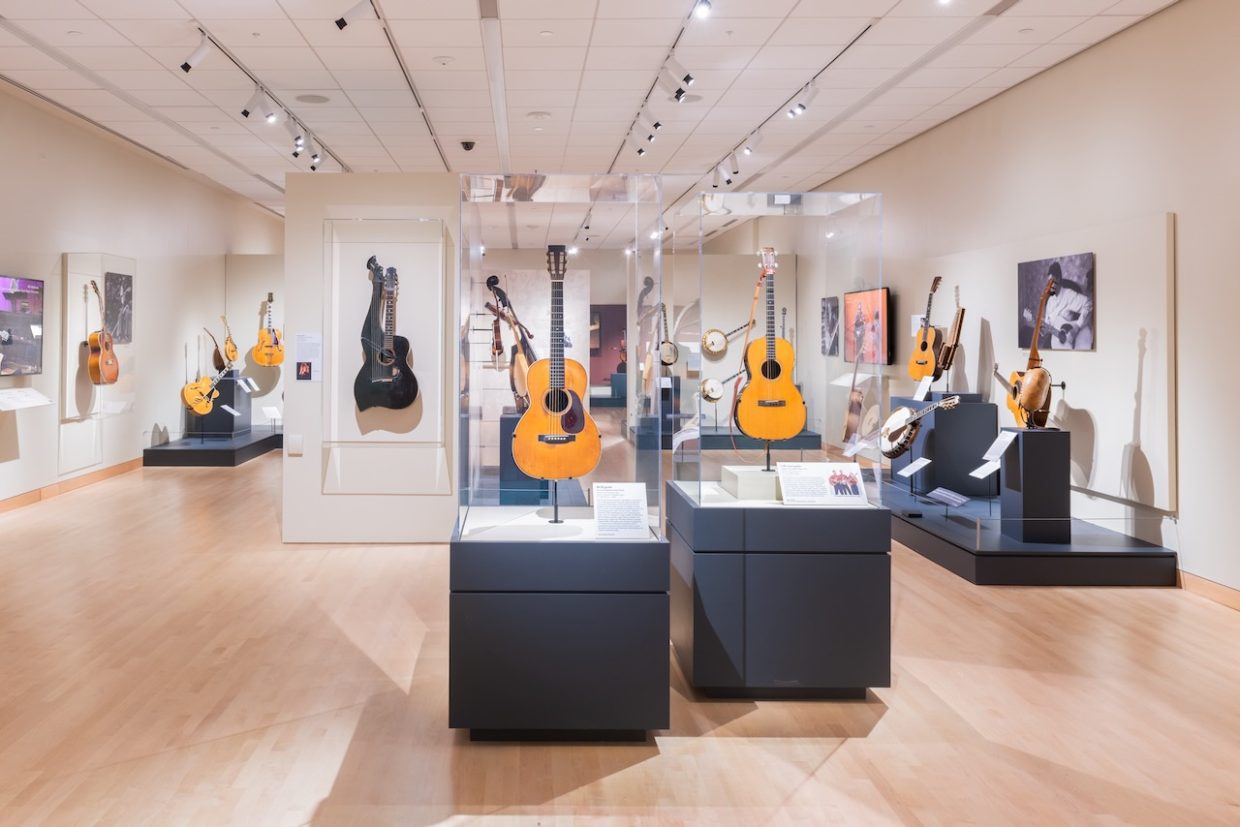
Guests of the museum will be able to view storied and legendary instruments formerly owned and played by such luminaries as Earl Scruggs, Elizabeth Cotten, Mississippi John Hurt, John Hartford, Lloyd Loar, and many more. “Beyond the legacies of the individual artists and the beauty of these historic instruments,” Walter continues, “Seeing this collection together in one space is really striking because it reflects a broader American narrative. Exceptional individuals from diverse backgrounds crossed paths and connected their talents in ways that gave us distinctive new traditions that continue to inspire people around the world.”
To celebrate the new exhibition and Dawg in December, we’ve partnered with MIM to bring you these photos of select instruments from Acoustic America. Make plans to visit the Musical Instrument Museum in Arizona now! Tickets are available at MIM.org.
(Editor’s Note: Instrument information provided from the Acoustic America catalog.)
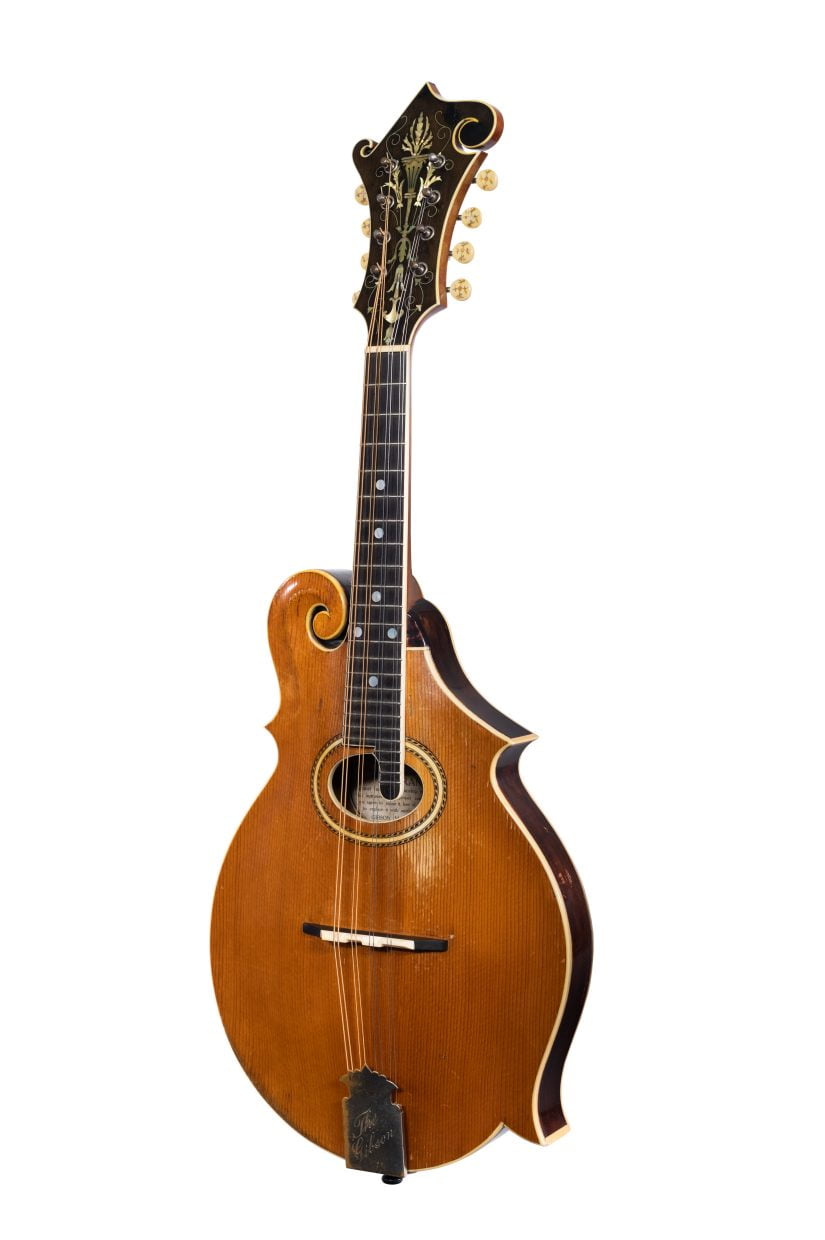
The F-4 model was Gibson’s premier mandolin until late 1922, when the F-5 was introduced. In addition to the characteristic oval sound hole and carved scroll, this early example features a three-point body style (note the points protruding from the body), elaborate torch and wire peghead inlay pattern, and special Handel tuning buttons with colorful inlays. David Grisman featured this mandolin on the cover of his first solo album, The David Grisman Rounder Album, and has recorded with it on other projects, including Tone Poems with Tony Rice and Not for Kids Only with Jerry Garcia.
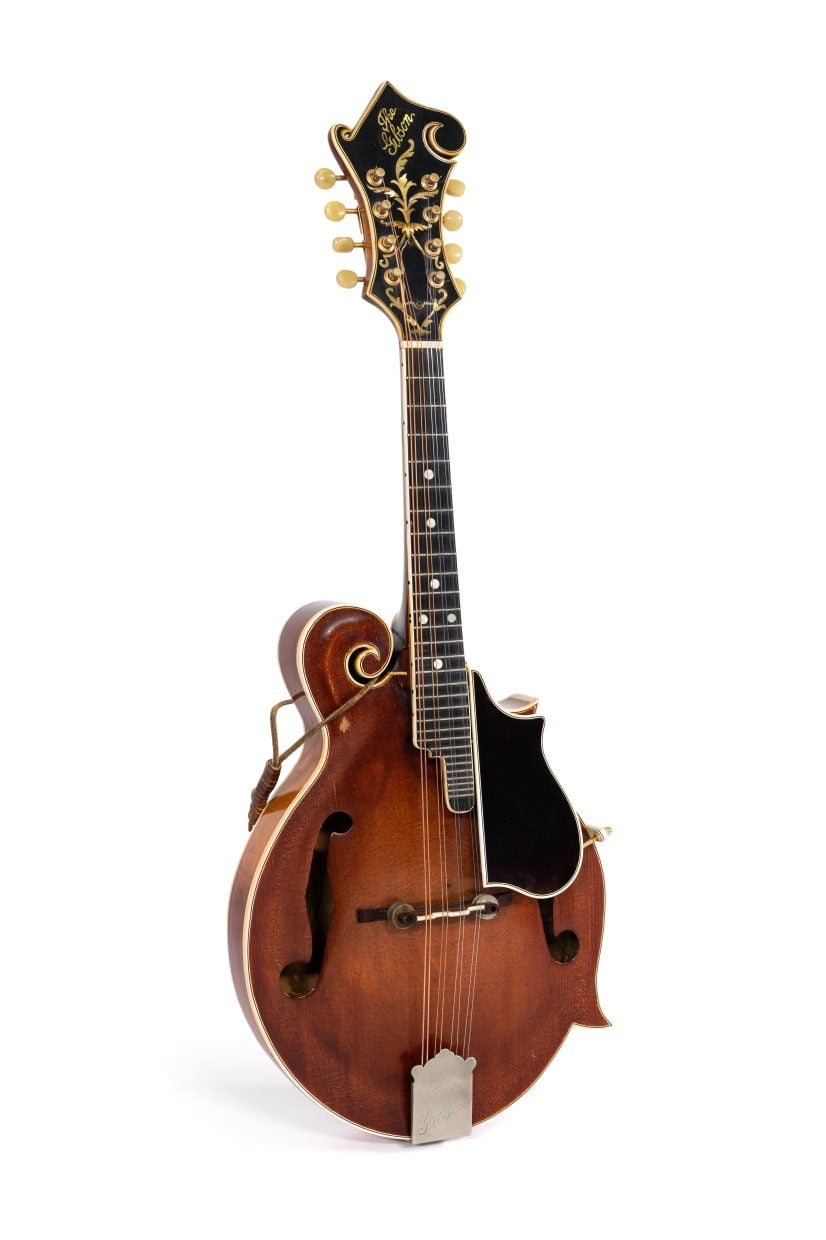
Manager, talented musician, and legendary folklorist Ralph Rinzler (1934–1994) was one of David Grisman’s earliest and most influential mentors. Sharing a hometown of Passaic, New Jersey, Rinzler introduced Grisman to important recordings of folk music and inspired him to play the mandolin. Rinzler played this F-5 mandolin with the Greenbriar Boys, who were the first non-Southern bluegrass band to win at the Union Grove Old Time Fiddler’s Convention in North Carolina. He also managed the careers of Doc Watson and Bill Monroe and was instrumental in creating the first dedicated bluegrass festival in Fincastle, Virginia, in 1965. Two years later, Rinzler founded the Smithsonian Folklife Festival to celebrate and support living cultural heritage from around the world.
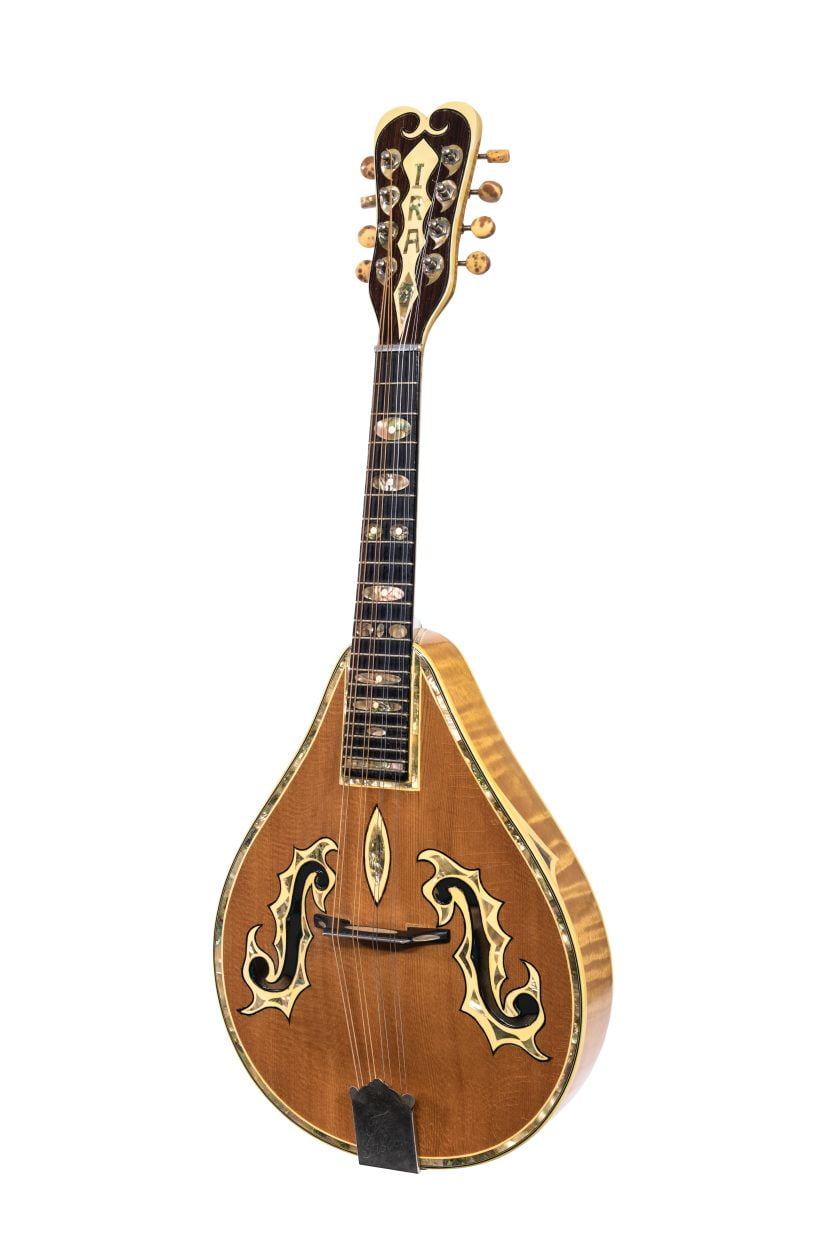
Few brother duet acts in country music were as influential as the Louvin Brothers. Ira and Charlie Louvin were born in Alabama in the 1920s, and their high harmony singing and Ira’s tasteful mandolin playing helped them define a sound popularized through radio broadcasts, commercial recordings, and appearances on the Grand Ole Opry – where they debuted in 1955. Ira customized this one-of-a-kind mandolin in the flashy style of professional country artists and played it extensively, including on the Grand Ole Opry stage. This special piece of mandolin history was also owned by David Grisman for many years.
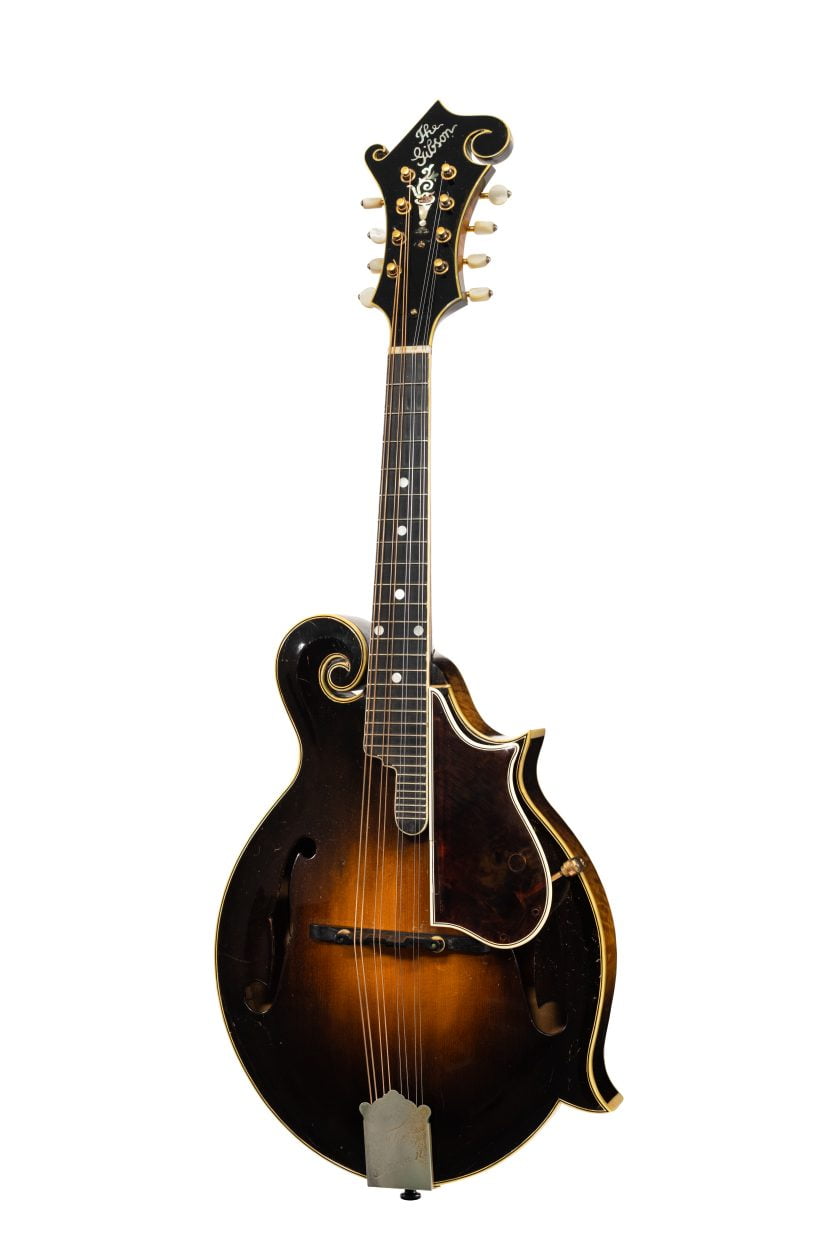
This mandolin — serial number 75315; label dated February 18, 1924 — was the personal instrument of famed Gibson acoustic engineer Lloyd Loar. Loar was impressively inventive and patented designs for keyboard actions and electric instruments, among many others, but the F-5 Master Model mandolin is arguably his most iconic and enduring success. The interior of this mandolin is fitted with an original Virzi Tone Producer. F-5 mandolins with Loar’s signature on the label are the most valuable and sought-after in the world, and Loar F-5s from the batch signed on this date are known to be among the best-sounding. Perhaps it is not surprising that Loar kept this remarkable mandolin for himself!
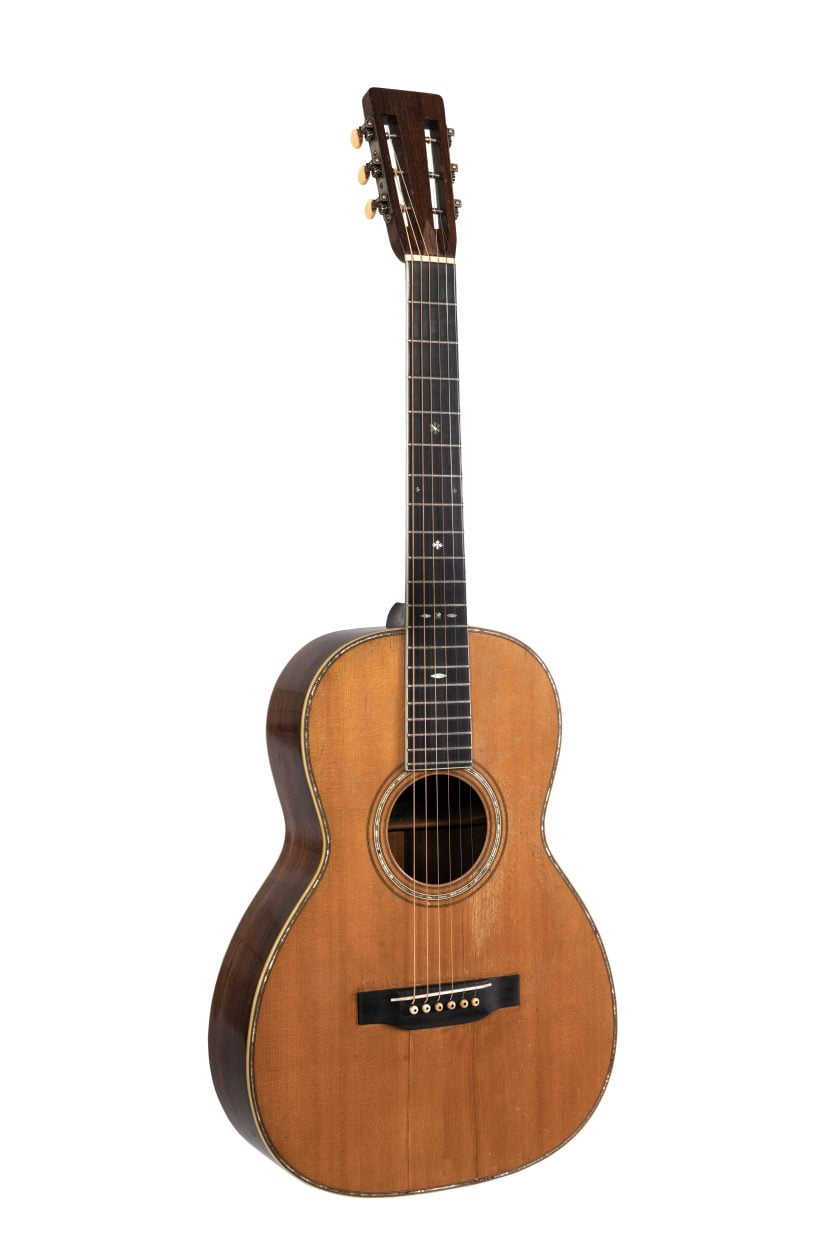
This guitar was played extensively by the New Lost City Ramblers, who were pivotal to the national revival of Southern folk music in the 1950s and 1960s. Founding members John Cohen, Tom Paley, and Mike Seeger were dedicated to authentically reproducing folk traditions for new audiences. The group recorded several albums for Smithsonian Folkways and helped discover, document, and showcase talented artists such as Elizabeth Cotten, Dock Boggs, and Snuffy Jenkins. Prewar pearl-trimmed Martin guitars are among the most desirable acoustic instruments in the world.
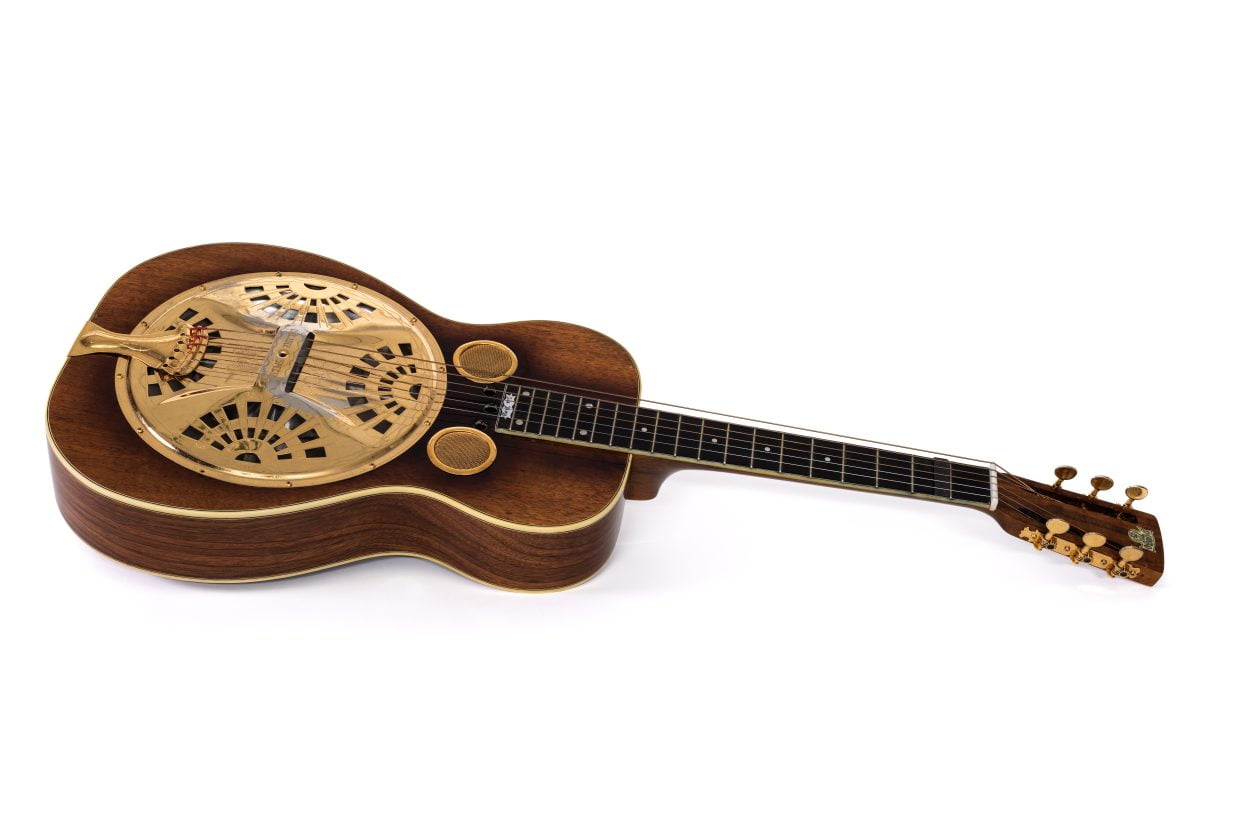
In 1961, the Kentucky Colonels, led by brothers Clarence and Roland White, performed on The Andy Griffith Show, under the alias “the Country Boys.” The Kentucky Colonels were one of the most exciting and influential bluegrass bands of their era, and their national television appearance would have been much of the United States’ first memorable exposure to bluegrass. Dobro player LeRoy McNees (AKA LeRoy Mack) played this Model 125 resophonic guitar during the show and for many years afterward. After the guitar was damaged at an airport, McNees restored and outfitted it with gold-plated metal hardware.
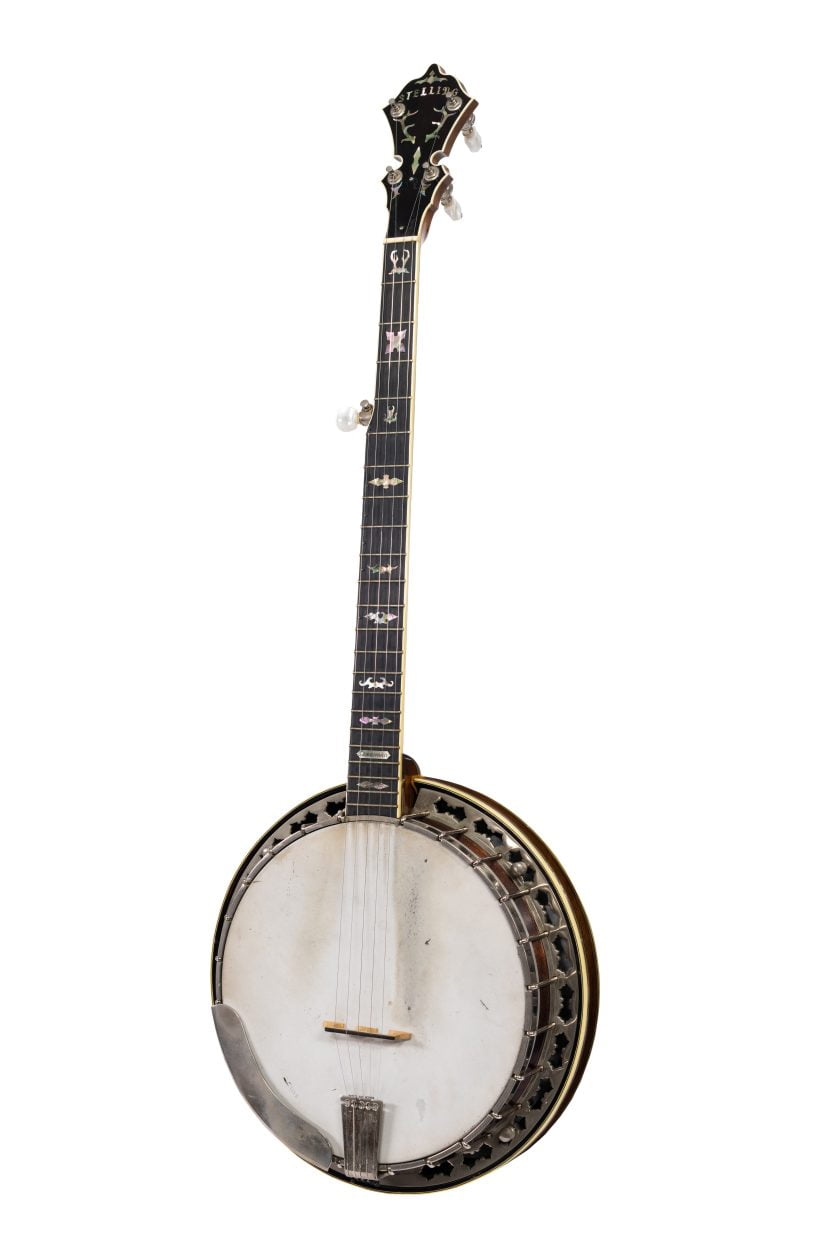
A young Alison Brown spent her entire savings on this then-new banjo built by Geoff Stelling, hoping to emulate the crisp, solid tone of Alan Munde, an influential older banjoist who played a similar Staghorn model. Brown played this banjo on her first album, 1981’s Pre-Sequel, and she later played it with Alison Krauss’s successful band Union Station. One of the most gifted banjoists in the world, Brown was the first woman voted Banjo Player of the Year by the International Bluegrass Music Association (in 1991). She has also won multiple Grammy awards, founded her own record label, Compass Records, and was inducted into the Banjo Hall of Fame in 2019.
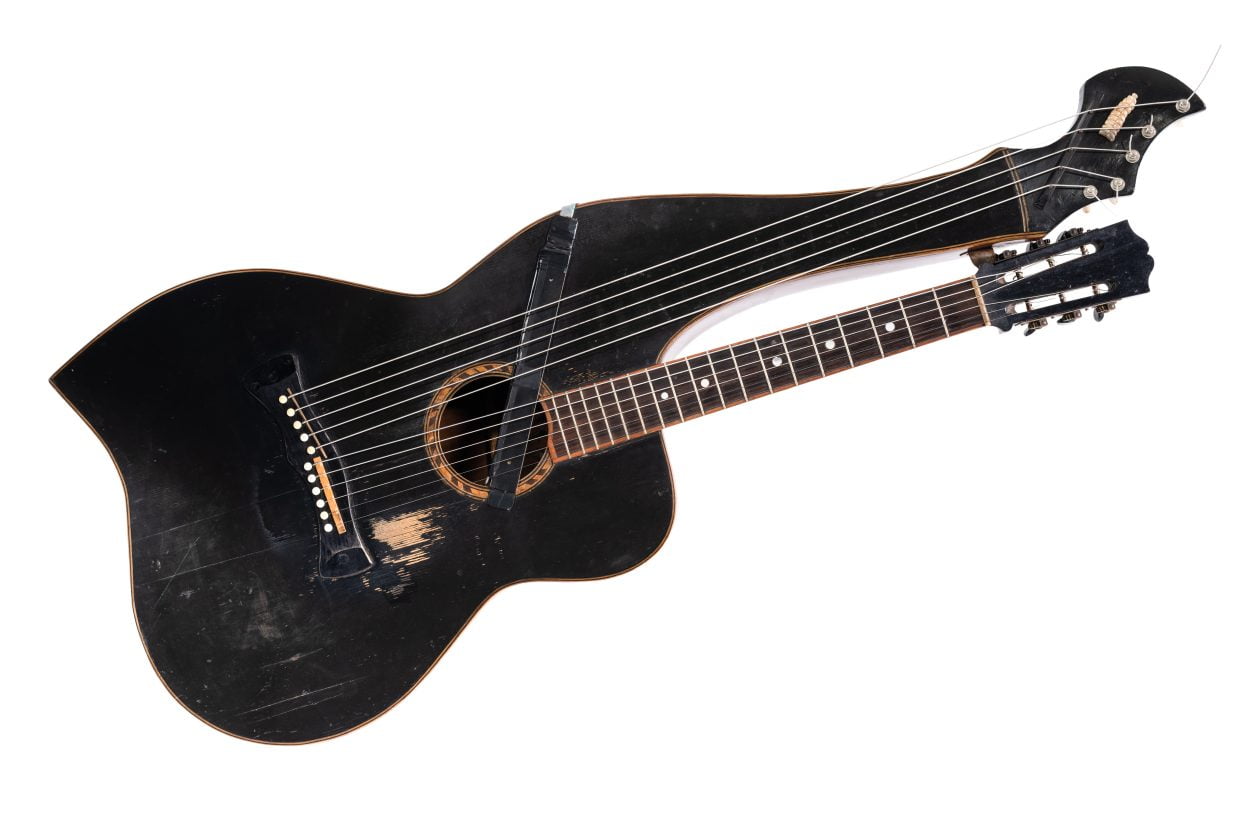
Guitarist and composer Michael Hedges (1953–1997) used a range of innovative and unconventional playing techniques — such as alternate tunings and percussive tapping on the strings and soundboard — to expand the possibilities of what a solo artist could do. In rediscovering the sound of vintage harp guitars with dedicated sub-bass strings, Hedges reimagined the guitar as a full-spectrum compositional tool. His 1984 album Aerial Boundaries illustrated his astonishing talent and helped define the contemporary new age acoustic music of Windham Hill Records. Hedges nicknamed this favored harp guitar “Darth Vader,” and his use of harp guitars revived interest in these long-obscure instruments.
All photos courtesy of the Musical Instrument Museum, Phoenix, Arizona.